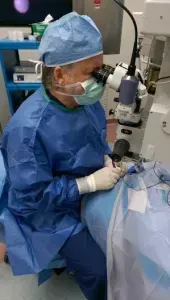*Please note new safety measures enacted during the coronavirus pandemic on Home Page
Your First Consultation with Dr. Luttrull
It is important for you to know that a thorough vitreoretinal examination as performed by Dr. Luttrull requires that your eyes be dilated. Therefore, it is wise to bring sunglasses and a driver as your vision may remain blurred for several hours after examination.
A medical history questionnaire will be mailed to you prior to your visit, unless you are seen on an emergency basis. Please help us by completing the form and bringing it with you to the office. This information will be made part of your medical record, and assist Dr. Luttrull in assessing your condition and recommending treatment.
Please set aside 1–2 hours for your visit. In addition to your consultation with Dr. Luttrull, for your convenience, every attempt will be made to complete all diagnostic tests and treatment at the time of your visit. Because of the wide variety and complexity of problems referred to Dr. Luttrull, including emergency patients who must be seen promptly, your patience with any delay during your visit is appreciated. Please understand that any such delays are both unforeseen and unavoidable, and necessary to assure each patient the highest quality of care.
The Examination
Dr. Luttrull’s assistant will take a brief ocular and medical history and check your visual acuity. Please bring your glasses or contact lenses so that the best assessment of your visual acuity can be made. Dr. Luttrull will then check your pupillary responses, an important part of any basic ophthalmologic examination, and your pupils will be dilated.
After allowing time for dilation to occur, you will meet again with Dr. Luttrull, who will take further information from you regarding the reason for your visit, and perform a thorough vitreoretinal examination.
Special Diagnostic Testing
The diagnosis and monitoring of vision problems due to retinal diseases is one of the most technologically intensive and advanced areas in medicine. In addition to new, higher resolution photography and angiography (photography of the retinal circulation), retina practice has been revolutionized by Optical Coherence Tomography (OCT) – giving Dr. Luttrull to see the very cellular structure of the retina. Making it’s debut only about 15 years ago, OCT has already progressed through many generations and is now an essential part of nearly every retinal evaluation.
In addition to the standard retinal diagnostic procedures described above, Dr. Luttrull’s ground-breaking work developing new retinal treatments has lead him to use other new technologies, and bring technologies to the retina field not normally employed by retina specialists, in entirely new ways to improve the diagnosis and management of important retinal diseases. Depending upon your diagnosis, such special testing and monitoring may be recommended by Dr. Luttrull, and explained to you fully before testing.
Dr. Luttrull will provide a prompt and detailed report of his findings, impressions, recommendations, and any treatment performed or recommended to your referring doctor, and other doctors who may have an interest in your care, such as your primary care physician and / or optometrist.Status reports regarding any subsequent visits are also often sent, and Dr. Luttrull will take care to provide you referring doctor periodic updates of your condition should it require his prolonged and / or frequent attention.


